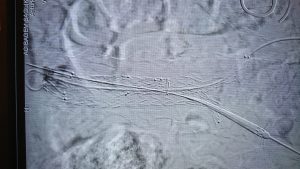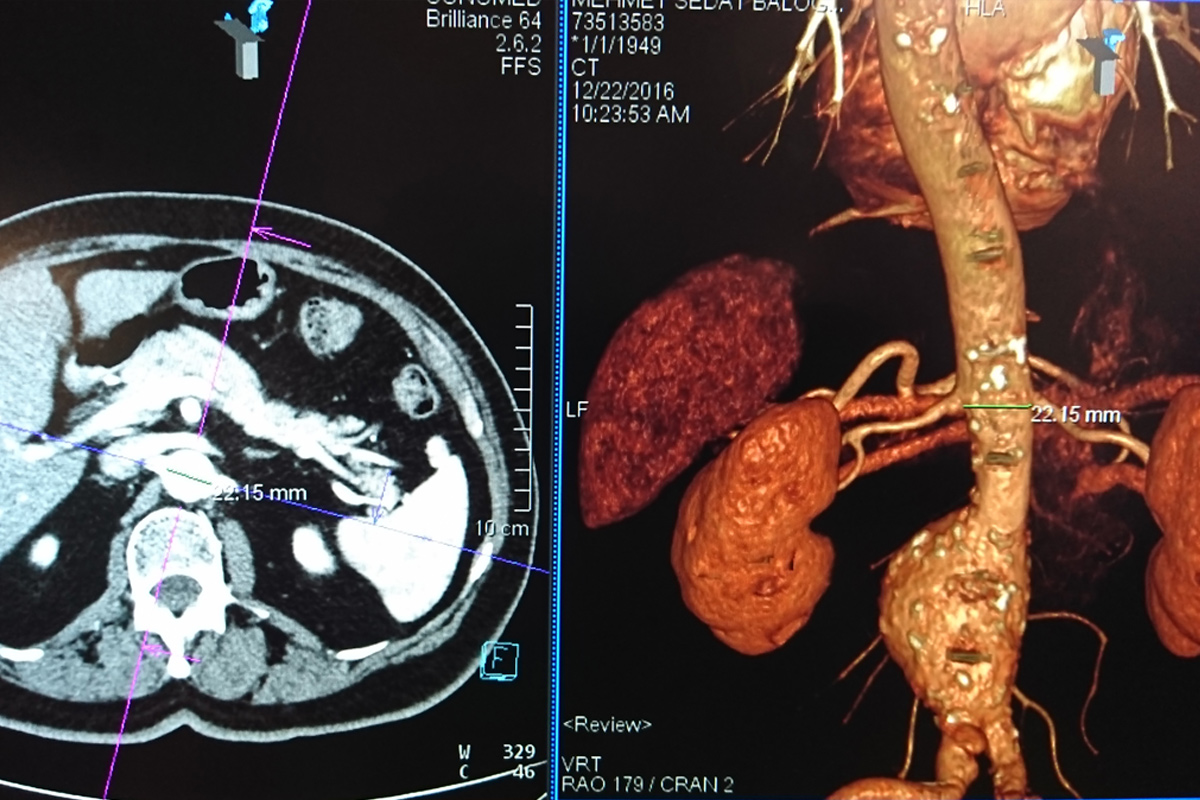Vascular Aneurysm
What is aneurysm and where can it be seen?
An aneurysm is defined as an artery in the body that bulges to twice its normal diameter. It most commonly occurs in the abdominal aorta, while the popliteal artery is the most common site for peripheral aneurysm.
What are the findings in abdominal aortic aneurysms?
Abdominal aortic aneurysms are generally silent. Mild abdominal pain may occur in half of patients. However, abdominal pain is a very indefinite symptom and can occur with many conditions. Sometimes a pulsatile swelling is felt in the abdomen or groin. Most of these patients are diagnosed during examinations such as ultrasound and computed tomography, which are performed for other reasons.
How is it diagnosed?
Abdominal aortic aneurysm can be diagnosed by ultrasound, magnetic resonance, and computed tomography angiography. Yet, CT angiography is the most useful method to select the treatment method and determine the details of the anatomy of the disease.
Why is abdominal aortic aneurysm important?
Under normal conditions, abdominal aortas 2-3 cm in diameter pose no risk until they reach 4.5-5 cm. However, abdominal aortas larger than 5 cm increase the risk of spontaneous rupture by 50%. Half of the patients with spontaneous rupture die before arriving the hospital, and the risk of dying during the procedure/surgery is about 50% for the half that can arrive the hospital. Therefore, diagnosis and follow-up of abdominal aortic aneurysms and choosing the right treatment at the right time are important.
When is surgical or interventional treatment performed for abdominal aortic aneurysms?
Aneurysms less than 5 cm in diameter should be followed up at 6-month or 1-year intervals. Surgical or endovascular intervention is required in patients with a diameter greater than 5.5 cm, with an increase in diameter of more than 0.5 cm within 6 months, or in patients with a diameter of 4.5-5.5 cm whose pain complaints persist despite all types of medical treatment.
How a surgery is endovascular aneurysm repair (EVAR)?
EVAR is performed in the angiography room and applied only through 5 cm incisions in the groin. This procedure, which can be used in patients with an abdominal aorta with suitable anatomical features, has a lower risk of mortality and fewer complications compared to surgical treatment.
With EVAR, a procedure that can be performed under general or local anesthesia, the procedure time is shorter, and discharge, return to normal life, and recovery are significantly faster than with surgical treatment.
 After assessing the anatomical features of the abdominal aorta in 3D with computed tomography, individual and special stent grafts are harvested for each patient. First, both arteries in the groin (femoral arteries) are surgically dissected in the angiography room and the stent grafts harvested specifically for the patient are inserted into the artery in such a way that the vascular aneurysm areas are closed by the procedure through these arteries. Then the incisions are closed by repairing the arteries and completing the process.
After assessing the anatomical features of the abdominal aorta in 3D with computed tomography, individual and special stent grafts are harvested for each patient. First, both arteries in the groin (femoral arteries) are surgically dissected in the angiography room and the stent grafts harvested specifically for the patient are inserted into the artery in such a way that the vascular aneurysm areas are closed by the procedure through these arteries. Then the incisions are closed by repairing the arteries and completing the process.
Is surgical treatment still performed for abdominal aortic aneurysm?
Although EVAR plays a very important role in the treatment of abdominal aortic aneurysms thanks to technological and technical developments, the need for surgical treatment remains in certain groups of patients.
Although the length of hospital stay, likelihood of death and complications, hospitalization after the procedure, and duration to return to normal life are higher, surgical treatment remains the only option in patients whose anatomical characteristics are not suitable for EVAR.
Aneurysms
Tags: vascular aneurysm, aneurysm, aortic aneurysm, aorta replacement, EVAR, stent, graft, bulging

